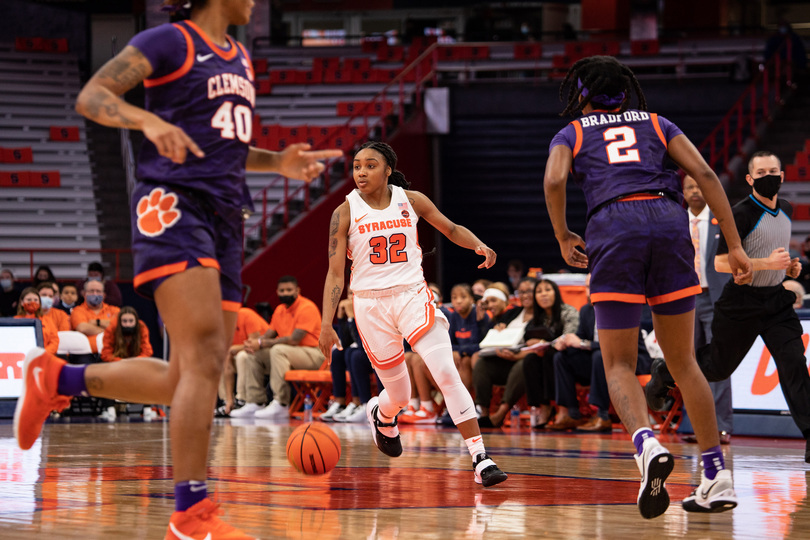Previewing Syracuse’s unlikely run through the ACC Tournament

Syracuse enters the ACC Tournament as the 12th seed. Trent Kaplan | Staff Photographer
Get the latest Syracuse news delivered right to your inbox.
Subscribe to our sports newsletter here.
Syracuse was on the brink of the NCAA Tournament’s bracketology in mid-December after an 8-4 start that featured a win over then-No. 18 Ohio State. Since then, the Orange have won just three games and quickly fell to the bottom third of the Atlantic Coast Conference standings.
Now Syracuse heads into the ACC Tournament as the 12th seed and on a five-game losing streak, its second-longest of the season. The Orange were among the conference’s worst shooting and rebounding teams all year, yet they led the conference in steals. Still, a deep run against a field of teams that features six ranked opponents — two within the top five — is an uphill battle for a Syracuse team that struggled in nearly each conference game it played.
Here’s Syracuse’s (11-17, 4-14 ACC) unlikely path to its first ACC title:
First Round — No. 13 Clemson
This is arguably Syracuse’s most favorable postseason matchup. The two will face each other on Wednesday, their first meeting since the Orange dominated Clemson 86-46 for their first conference win back in December.
It was the only time the Orange shot over 50% from the field against a conference opponent, while Clemson’s 25.4% was the lowest an SU opponent shot all season. Four Syracuse players scored at least 14 points, which included Christianna Carr’s 19-point performance, shooting 7-of-11 from the field and a season-best 5-for-7 from beyond the arc.
Like Syracuse, Clemson struggled against the ACC’s top teams, though it did defeat 11th-seeded Wake Forest twice. And with the departure of former Syracuse guard, Kiara Lewis, the Tigers have just 11 active players, just like SU.
But Syracuse is not shooting nearly as well as it was in December and will likely not win by as big of a margin. Chrislyn Carr and Teisha Hyman are coming off of 20 and 22-point games, respectively, and have been SU’s most consistent shooters recently.
Second Round — No. 5 Virginia Tech
No. 23 Virginia Tech handed Syracuse its biggest loss of the season. The Orange allowed 102 points, unable to stop 6-foot-6 center Elizabeth Kitley, the ACC’s tallest player. Although SU was outsized in nearly every conference game this season, Kitley and the Hokies’ play inside challenged it unlike any other team had this season.
But Syracuse didn’t do its part shooting either, making just 30.3% of its shots while Virginia Tech scored 58.1%, the second-best field goal percentage the Orange have allowed this season. The game was reminiscent of SU’s season-long fourth quarter struggles, as they made just one field goal and were outscored 22-5.
Syracuse will likely not have an answer for Kitley should it get a chance to redeem itself inside. Kitley has shot over 64% seven times this season and notched 24 points and 11 rebounds against SU.
Quarterfinals — No. 4 North Carolina
Syracuse was on its best run of the season when it faced then-No. 24 North Carolina on Dec. 30. It was undefeated through five games in December, which featured a win over Ohio State, the Orange’s first conference win and a commanding set of 30-plus point wins over nonconference opponents.
Then COVID-19 ruled two starters out of Syracuse’s meeting with the Tar Heels, and the Orange traveled to Chapel Hill with only seven players. SU shot season-lows from the field and from beyond the arc, shooting 21.1% and 21.7%, respectively, and was held to a season-low in points in the 79-43 loss.
Even though a rematch won’t be nearly as lopsided, North Carolina will still exploit Syracuse. The Tar Heels rank second in the ACC in team rebounding, and are led by Alyssa Ustby, who averages 8.6 per game. They also hold opponents to just over 25% shooting from deep, the ACC’s best 3-point shooting defensive unit.
Semifinals — No. 1 NC State or No. 8 Boston College or No. 9 Florida State
Each of these teams handed Syracuse a combined four losses this season, where it allowed at least 50 points in the paint during three of them.
Games against the Eagles and the Wolfpack were lost from the get-go, featuring top shooting performances by both teams. BC shot over 55% in seven of its eight quarters against the Orange, while the Wolfpack made over 52% of their field goals in the first three quarters.
The meeting with the Seminoles, however, was much closer early on. Syracuse only trailed by four at halftime but shot just 4-for-18 in the second quarter, foreshadowing a dismal second-half shooting performance.
It’s unlikely that the winner of the Boston College-Florida State second round tilt will be able to handle NC State, who lost just one conference game all season. Although the Eagles did force the Wolfpack into overtime on Feb. 10, they were outscored 15-8 in the extra frame. Still, SU’s prior potential matchups will be enough of an uphill battle before it shifts focus to what could be a repeat of last year’s ACC Tournament success.





